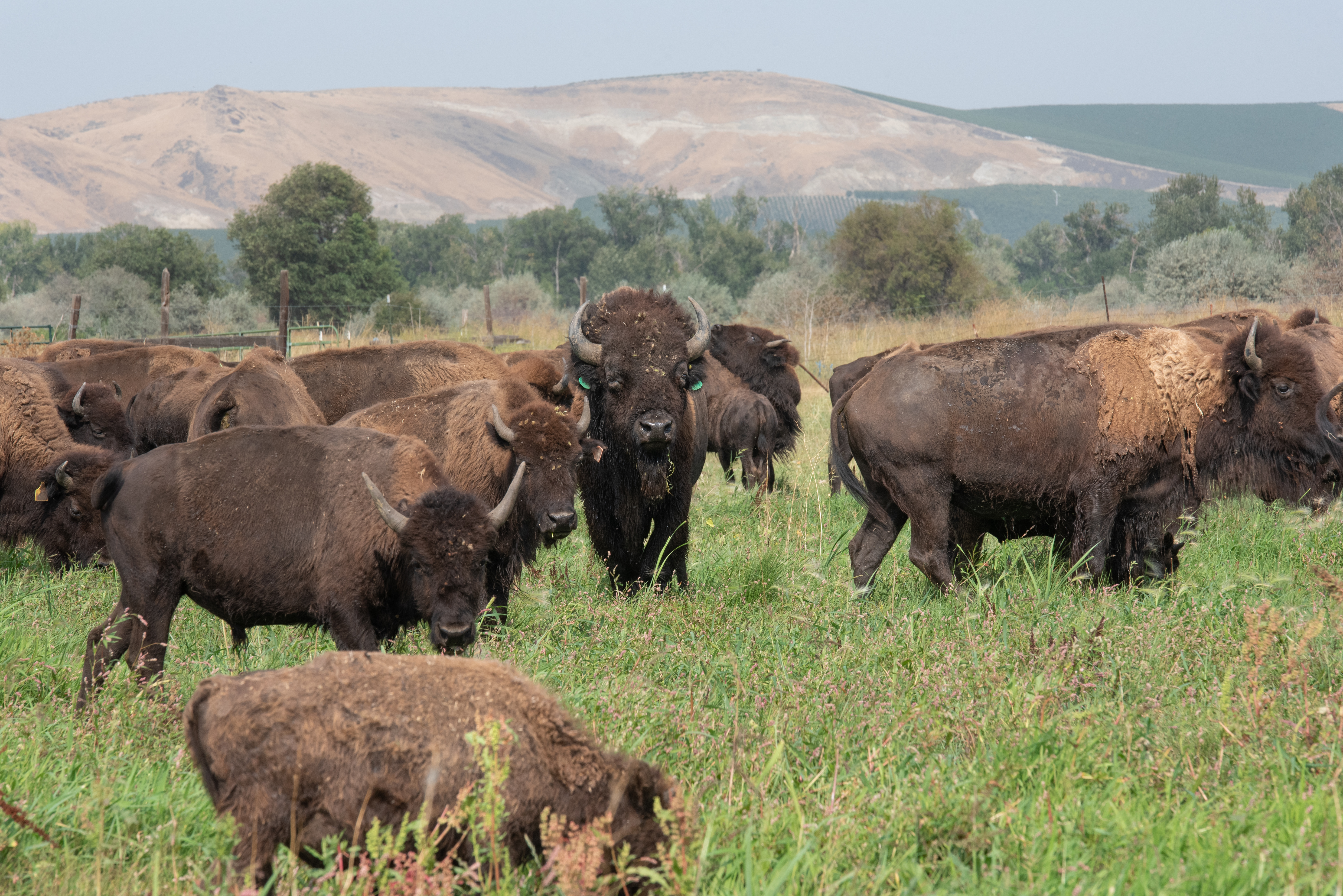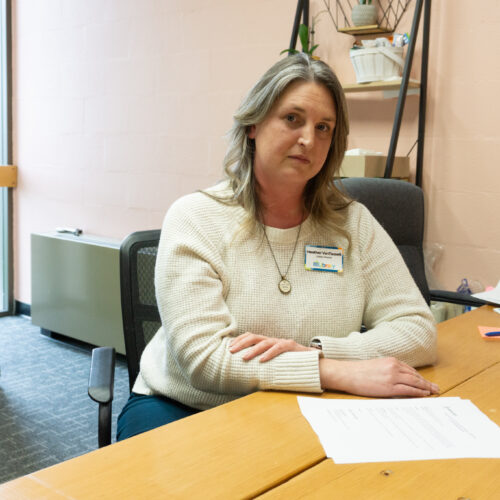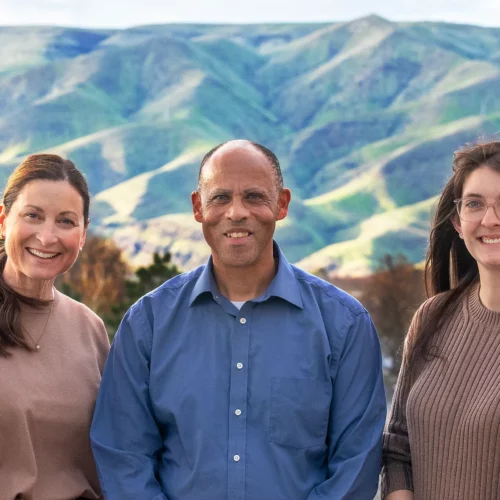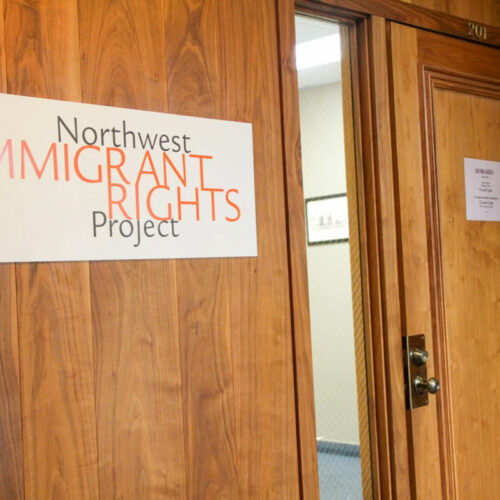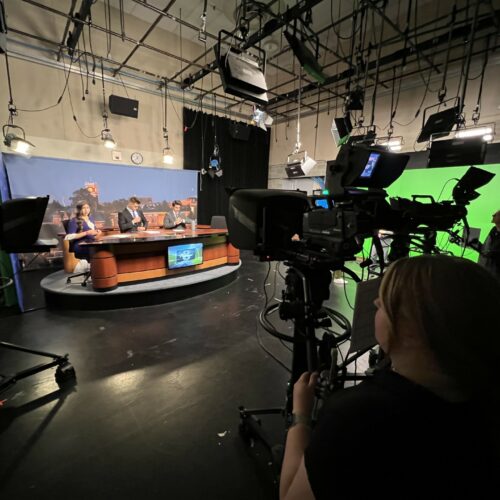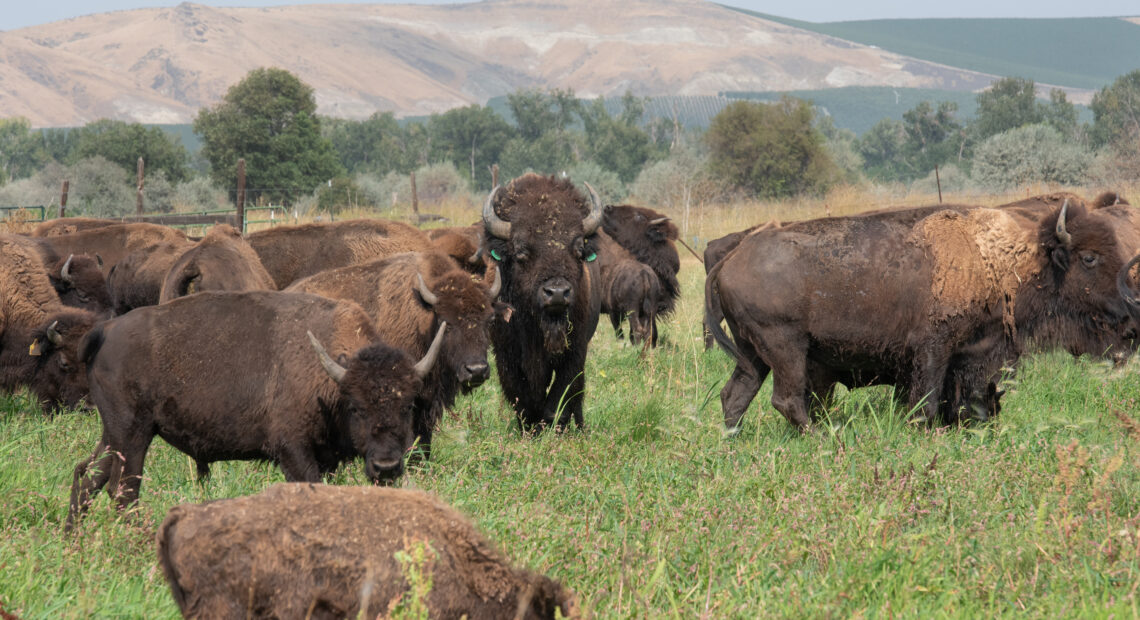
Why the Yakama Nation has a herd of buffalo – and why it’s growing
Listen
(Runtime 4:06)
Read
A buffalo herd is a rare site in Washington. But, on the edge of the Yakima River, not far from an interstate among the hop and corn fields, nearly 200 buffalo roam just outside of the small farming town of Toppenish.
“You can feel them running towards you,” said Darwin Sockzehigh. “Their power behind them and especially when they’re all bunching up. They’re all bumping off each other and you can hear the grunts and their breath and their bodies moving.”
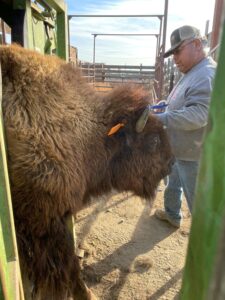
Darwin Sockzehigh administers a vaccine to a buffalo cow at the tribe’s Satus Ranch during last year’s round up. (Courtesy of Kristi Olney)
Sockzehigh has managed the Yakama Nation’s buffalo herd for the past five years, in this slightly unusual place.
“The landscape that we’re in right now, I don’t think it’s really buffalo habitat,” he said. “It’s kind of marshy and stuff. I guess I’m used to seeing buffalo on plains, which we have somewhat dry areas. We’re kind of right in the between area, desert to the alpine country.”
The Yakama Nation is building up its little-known buffalo herd – the herd is so off-the-radar many tribal members don’t know it exists. The tribe recently brought buffalo from Yellowstone to Central Washington, with a plan to help Yakama Nation members become more food sovereign.
When Sockzehigh first started working with the herd, he said he would walk around with them, just to let them know he was there.
“We kind of got that respect now that they know when I’m there, I’m not there to hurt him. I’m just there to help them out,” he said.
The tribe first started developing a herd in the early 90s.
“You can tell that they’re thinking if you look at them,” Sockzehigh said of the buffalo. “They’re trying to figure things out right away.”
Two years ago, the InterTribal Buffalo Council awarded the Yakama Nation a family group of 26 buffalo from Yellowstone.
“They came early in the morning, about five o’clock, so we had to get up and hustle around and get down here,” Sockzehigh said. “They’re quite a bit bigger than the herd that we have.”
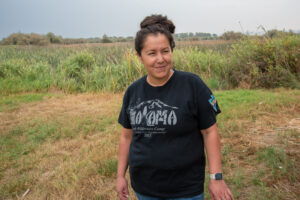
Kristi Olney is the lead biologist for the Yakama Nation Wildlife Program, which oversees the buffalo herd. She said the tribe brought in buffalo from Yellowstone to create genetic diversity within the herd. “The Yellowstone buffalo, they’re more pure, more wild,” she said. (Credit: Annie Warren)
The plan was to create genetic diversity within the herd, said Kristi Olney, the lead biologist for the program.
“The Yellowstone [buffalo], they’re more pure, more wild,” she said.
That means less bovine genetics in the herd, which could eventually make the meat even leaner and healthier than beef.
It’s all part of a plan to increase food sovereignty for tribal members, said Tribal Council member Caseymac Wallahee. Traditionally, he said tribal members gather, hunt and fish.
“Those have always been the main staples in our diets. That kept our people healthy,” he said.
But, tribally-raised buffalo can help provide a healthier meat. “So it would help our people,” Wallahee said.
While buffalo aren’t part of the Yakama Nation’s culturally important foods, Wallahee said there’s evidence some Yakama hunters traveled east – buffalo bones have been found here as well as hides.
Tribal ancestors also traded for buffalo long ago at the region’s largest trading center for centuries: Celilo Falls on the Columbia River.
“People would come from Montana, the Dakotas, come this way and trade for their bison and we would give them our salmon,” he said.
Now, the buffalo program aims for more tribal members to eat healthier buffalo meat. Like Yakama Nation member Jonathan Brown. He started buying buffalo meat last year, buying a little more every paycheck.
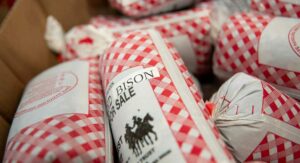
The Yakama Nation has a freezer full of buffalo hamburger and stew meat. The buffalo program aims to sustain itself through meat sales to both tribal and non-tribal members. Eventually, program leaders say they would like to be able to donate meat to the tribal headstart program, casino daycare and the elders program. (Credit: Annie Warren)
“Our freezer is full, but we intend to keep it more full and keep buying it,” Brown said.
Now, he said, it’s a main staple for his family.
“We do spaghetti. Of course, patties. We just mix it with rice. We just kind of be creative with it,” Brown said. “We make buffalo chili. I think that’s my favorite thing, with fry bread, of course.”
Back on the ranch, there’s a freezer full of meat.
“The packages that sell the most are the hamburger and the stew meat,” Sockzehigh said.
The tribe has so successfully bred and raised its herd that biologists and tribal members from the Confederated Tribes of the Warm Springs in Central Oregon toured the tribes’ Satus Ranch, where the herd is based, to get some advice. The Warm Springs tribe says it’s considering building up its own buffalo herd – but that’s still years away.
For the Yakama Nation program, the goal is to sustain around 200 buffalo on a healthy pasture – and one day be able to donate meat to the tribal headstart program, casino daycare, and the elders program. Right now, the buffalo program is self-funded through meat sales, Olney said.
“The buffalo have to pay for themselves. Everything that the buffalo make just comes right back into them,” she said.
First, the wildlife team have to get the word out – to more people than the neighbors. Sockzehigh said when the herd wants to move, it moves. And sometimes escapes. He’s gotten calls to help bring the herd back from Granger, roughly seven miles away. And once, farther down the road.
“They jumped the Yakima River. They were making their way to Mabton,” he said.
That’s nine miles in the opposite direction. But, he says, the program is heading just where it’s supposed to go.
“It’s really good food. It’s good meat to eat. So yeah, I just kind of want to bring that back here to our tribe to let them know that, too,” he said.

